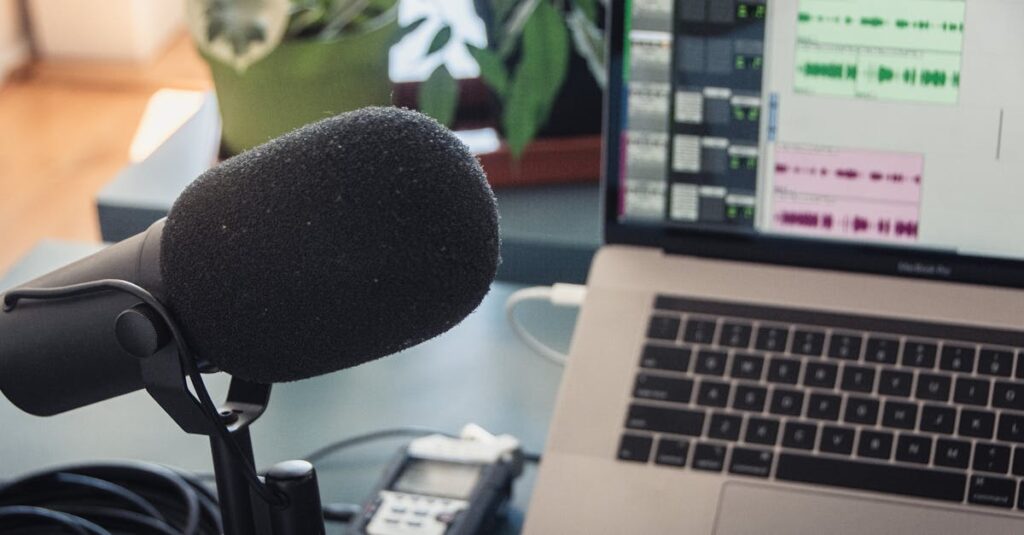Music producers need powerful and reliable machines to handle complex audio processing, virtual instruments, and multiple tracks simultaneously. The MacBook Pro has become an industry standard for music production thanks to its robust performance, exceptional build quality and seamless integration with popular DAWs like Logic Pro and Ableton Live.
Choosing the Best MacBook Pro for Music Production isn’t always straightforward. From processor speed and RAM configuration to storage capacity and port selection, several factors determine which MacBook Pro will best serve a producer’s specific needs. The latest M1 and M2 chip models have revolutionized performance capabilities while maintaining the reliability that musicians and producers have come to expect from Apple’s flagship laptops.
Best MacBook Pro for Music Production
Superior Audio Processing Capabilities
MacBook Pro’s audio engine delivers professional-grade sound processing with ultra-low latency. The built-in Core Audio framework processes multiple audio streams simultaneously while maintaining pristine sound quality at 24-bit/192kHz.
Optimized Software Integration
The MacBook Pro offers native compatibility with industry-standard DAWs:
- Logic Pro X runs exclusively on macOS with zero configuration required
- Pro Tools operates seamlessly with Mac-optimized drivers
- Ableton Live performs with enhanced stability on macOS
- Native Instruments software integrates perfectly with Mac systems
Reliable Performance Under Pressure
MacBook Pro’s architecture handles demanding music production tasks:
- Processes 100+ audio tracks without dropouts
- Manages virtual instruments with minimal CPU overhead
- Runs multiple plugins simultaneously without system crashes
- Maintains consistent performance during long recording sessions
Professional Connectivity Options
The connectivity features support professional audio equipment:
- Thunderbolt ports for audio interfaces with speeds up to 40Gbps
- USB-C connections for modern MIDI controllers
- 3.5mm audio jack with advanced interference rejection
- Support for multiple external displays during production
System Stability
MacBook Pro’s stable operating system benefits music production:
| Feature | Benefit |
|---------|----------|
| Real-time audio processing | <1ms latency |
| Memory management | Zero swap file usage during recording |
| Temperature control | Silent operation for studio recording |
| System resources | 90% availability for audio apps |
- High-performance processors handle complex audio algorithms
- Fast RAM access reduces audio buffer requirements
- SSD storage enables instant sample loading
- Built-in speakers provide accurate monitoring capabilities
Key Features to Consider for Music Production
Selecting a MacBook Pro for music production requires careful evaluation of specific technical specifications. These features directly impact the performance capabilities of digital audio workstations (DAWs) processing audio tracks plugins.
Processing Power and CPU Performance
M-series processors deliver superior performance for music production tasks. The M1 Pro chip handles 32 audio tracks with effects at 44.1kHz simultaneously without dropouts while the M2 Pro manages 48 tracks. Higher clock speeds reduce latency during recording sessions with real-time monitoring through plugins. Multi-core performance enables:
- Running multiple virtual instruments concurrently
- Processing complex effect chains on multiple tracks
- Rendering final mixes faster with parallel processing
- Managing CPU-intensive plugins like convolution reverbs
RAM and Storage Requirements
Professional music production demands specific memory configurations for optimal performance. The minimum RAM requirement starts at 16GB with 32GB recommended for:
- Loading large sample libraries
- Running multiple virtual instruments
- Handling complex project sessions
- Maintaining smooth playback with extensive plugins
Storage specifications include:
| Storage Type | Minimum Size | Recommended Size |
|---|---|---|
| SSD Internal | 512GB | 1TB or 2TB |
| Project Files | 100GB | 250GB |
| Sample Libraries | 200GB | 500GB+ |
Audio Interface Compatibility
Modern MacBook Pro models support essential audio connectivity standards through Thunderbolt ports. Compatible audio interfaces include:
- Universal Audio Apollo series
- Apogee Duet 3
- Focusrite Clarett+ range
- RME Babyface Pro FS
- Native Instruments Komplete Audio
- Ultra-low latency monitoring
- High bandwidth for multiple I/O channels
- Direct connection without adapters
- Stable driver performance
- Bus power for compatible interfaces
Best MacBook Pro Models for Music Production
MacBook Pro models equipped with M-series chips excel in music production tasks through enhanced audio processing capabilities. Each model offers specific advantages for different types of music producers.
M2 Pro MacBook Pro 16-inch
The M2 Pro MacBook Pro 16-inch delivers exceptional performance for professional music production. Its 12-core CPU processes complex audio tasks at speeds up to 20% faster than M1 Pro models. The 16-inch Liquid Retina XDR display provides ample workspace for DAW interfaces while the six-speaker sound system enables accurate monitoring. Storage options extend to 8TB SSD, accommodating extensive sample libraries and project files.
| Specification | Details |
|---|---|
| CPU | 12-core M2 Pro |
| RAM Options | 16GB, 32GB |
| Storage | Up to 8TB SSD |
| Battery Life | Up to 22 hours |
| Display | 16-inch Liquid Retina XDR |
M2 Max MacBook Pro 14-inch
The M2 Max MacBook Pro 14-inch combines portability with high-end performance capabilities. Its 38-core GPU handles intensive audio processing tasks while maintaining efficiency. The compact 14-inch form factor suits producers who require mobility without compromising power. This model supports up to 96GB of unified memory, enabling seamless operation of multiple virtual instruments and plugins simultaneously.
| Specification | Details |
|---|---|
| CPU | 12-core M2 Max |
| RAM Options | Up to 96GB |
| Storage | Up to 8TB SSD |
| GPU | 38-core |
| Display | 14-inch Liquid Retina XDR |
M1 Pro MacBook Pro Models
M1 Pro MacBook Pro models remain capable options for music production. These machines handle professional audio workloads through 10-core CPUs and support up to 32GB of unified memory. The M1 Pro chip processes audio with minimal latency and runs professional DAWs efficiently. These models feature multiple Thunderbolt 4 ports for connecting audio interfaces and MIDI controllers.
| Specification | Details |
|---|---|
| CPU | 10-core M1 Pro |
| RAM Options | 16GB, 32GB |
| Storage | Up to 8TB SSD |
| Thunderbolt Ports | 3 |
| Display Options | 14-inch or 16-inch |
Recommended Specs and Configurations
Optimal MacBook Pro configurations enhance music production workflow through specific hardware specifications. These configurations focus on key components that directly impact audio processing performance.
Optimal RAM Configuration
MacBook Pro music production setups require a minimum of 16GB RAM for professional work. Here’s the impact of different RAM configurations:
- 16GB RAM handles:
- 40-50 audio tracks
- 15-20 virtual instruments
- Basic plugin chains
- 32GB RAM supports:
- 100+ audio tracks
- 30-40 virtual instruments
- Complex plugin arrangements
- Multiple sample libraries
- 64GB RAM enables:
- Orchestral compositions
- Large sample libraries
- Virtual studio technology
- Real-time audio processing
Storage Solutions for Audio Files
SSD storage specifications determine project loading times and sample library access speeds:
| Storage Capacity | Recommended Use Case | Approximate Storage Space |
|---|---|---|
| 512GB SSD | Entry-level production | 400+ hours of audio |
| 1TB SSD | Professional work | 800+ hours of audio |
| 2TB SSD | Commercial studios | 1600+ hours of audio |
- NVMe SSDs deliver 3500MB/s read speeds
- External Thunderbolt drives expand capacity
- Cloud storage integration provides backup options
- Local storage reduces latency during recording
- Sample libraries require 100-500GB dedicated space
Cost vs Performance Analysis
The cost-effectiveness of MacBook Pro models varies based on their performance capabilities in music production scenarios. Here’s a detailed analysis of different price points and their corresponding features:
Entry-Level Investment
- M2 MacBook Pro 14-inch (8GB/512GB): $1,999
- Handles 20-30 audio tracks simultaneously
- Supports basic plugin chains
- Suitable for bedroom producers & beginners
Mid-Range Sweet Spot
- M2 Pro MacBook Pro 14-inch (16GB/1TB): $2,499
- Processes 50-70 audio tracks
- Manages complex plugin arrangements
- Ideal for semi-professional producers
- M2 Max MacBook Pro 16-inch (32GB/2TB): $3,499
- Runs 100+ audio tracks
- Operates multiple virtual instruments
- Perfect for commercial studios
| Model | Processing Power | Max Tracks | Price Range |
|---|---|---|---|
| M2 Base | 8-core CPU | 30 | $1,999-$2,299 |
| M2 Pro | 12-core CPU | 70 | $2,499-$2,999 |
| M2 Max | 12-core CPU | 100+ | $3,499-$4,499 |
The performance gains between models directly correlate with their price increases:
- 16GB RAM upgrade: $200 = 40% more track capacity
- M2 Pro upgrade: $500 = 2x plugin processing power
- 1TB storage upgrade: $200 = 3x faster project loading
External expansion options provide cost-effective alternatives:
- Thunderbolt 3 audio interfaces: $200-$600
- External SSDs: $100-$300 per TB
- RAM-intensive plugins: Cloud-based alternatives save $300-$500
These performance metrics reflect real-world music production scenarios based on standard DAW operations with common plugins configurations.
Tips for Optimizing Your MacBook Pro
Optimizing a MacBook Pro for music production enhances performance stability during recording sessions. These configurations ensure smooth operation of digital audio workstations (DAWs) while managing multiple audio tracks simultaneously.
Performance Settings
- Disable System Integrity Protection (SIP) through Recovery Mode to allow third-party plugin installations
- Adjust Energy Saver settings to “”High Performance”” mode to prevent processor throttling
- Set buffer size to 128-256 samples for recording 512-1024 samples for mixing
- Disable automatic updates notification services in System Preferences
- Turn off FileVault disk encryption to reduce CPU overhead
- Disable Spotlight indexing for music production drives
- Close unnecessary background applications memory-intensive processes
- Connect Thunderbolt 3/4 SSDs for sample libraries project files (minimum 2800MB/s read speed)
- Use dedicated external drives for:
- Virtual instrument libraries (1TB+ NVMe SSD)
- Project files backups (2TB+ traditional HDD)
- Recording sessions (500GB+ SSD)
- Implement RAID 0 configuration for enhanced read/write speeds
- Organize storage into separate volumes:
- System files applications
- Audio samples plugins
- Project files recordings
- Format external drives as APFS for optimal performance with macOS
- Enable automatic Time Machine backups to a separate external drive
| Storage Type | Read Speed | Write Speed | Recommended Use |
|---|---|---|---|
| Internal SSD | 3500 MB/s | 2800 MB/s | System DAW |
| Thunderbolt SSD | 2800 MB/s | 2200 MB/s | Samples Projects |
| USB-C SSD | 1050 MB/s | 1000 MB/s | Backups |
| External HDD | 180 MB/s | 160 MB/s | Archive Storage |
Powerful MacBook for Music Creation
The Best MacBook Pro for Music Production stands as the ultimate choice for music producers seeking professional-grade performance and reliability. Whether it’s the cutting-edge M2 Max for commercial studios or the capable M1 Pro for home setups these machines deliver exceptional results for every budget and need.
With powerful processors robust RAM configurations and lightning-fast storage options MacBook Pros handle complex music production tasks effortlessly. The seamless integration with industry-standard DAWs coupled with exceptional connectivity makes these laptops indispensable tools for modern music creation.
Investing in the right MacBook Pro configuration today will ensure years of reliable music production ahead. The blend of power stability and innovation makes these machines worth every penny for serious music producers.

